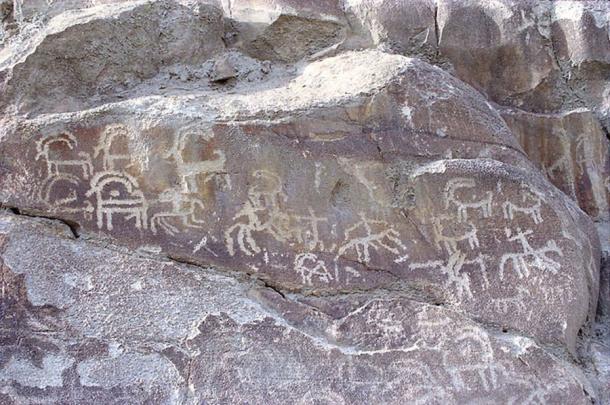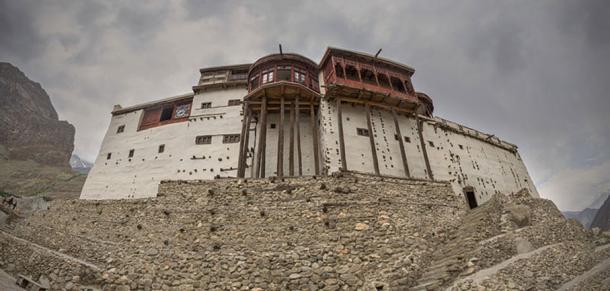This article was published on ancient-origins.net and Anicent Origins is an archaeology website which explores lost civilizations, examines sacred writings, tours ancient places, investigates ancient discoveries and questions mysterious happenings. Our open community is dedicated to digging into the origins of our species on planet earth, and question wherever the discoveries might take us. We seek to retell the story of our beginnings.
In his book Lost Horizon (1933) James Hilton created the legend of Shangri-La, a peaceful Himalayan valley of long-lived people. Where the northern border of the Gilgit-Baltistan region of Pakistan meets China, Afghanistan and Tajikistan, lies the hidden Hunza Valley. Scarcely 160 kilometers (100 miles) long and only 1.6 kilometers (one mile) wide, the nestled valley is framed by the Tien-Shan mountain to the north, the Hindu-Kish mountain to the west, the Kara-Korum mountain to the east and the southern Himalayan mountain range. Remote, inaccessible and sheltered, the Hunzakuts have managed to preserve and protect their culture and their secret to longevity from the modern world. While researching the Himalayan brown bear in 2010, conservationist and adventurer Willem Daffue , found himself in a position where his mountaineering expedition went awry due to the worst floods in Pakistan in centuries. Stranded in the Hunza Valley, he met these remarkable people, whom legends refer to as reaching ages well beyond the centenary mark.
 |
| Petroglyphs in the Hunza Valley area. ( jackylim/ CC BY-SA 3.0 ) |
More than 50,000 petroglyphs in the region, created by invaders, traders and pilgrims provide a historical account carved in rock, suggesting that the Hunza Valley has been occupied by humans for at least 2000 years. When the Muslim conquerors settled in the Hunza-Nagar Valley about 1,000 years ago, the ruling family of Gilgit produced twin sons, who, according to folklore, competed with each other from birth. Their father divided the state between them.
 |
| A panoramic view of Baltit Fort. ( CC BY-SA 3.0) |
The rulers of Hunza carry the title Mir and settled their capital at Baltit, (present-day Karimabad) for more than 750 years, since the 13th century. The Baltit Fort became the palace of the rulers, but also an assembly point for caravans, trading in slaves. Under the British rule of India, Hunza was a former princely state, a vassal state in a subsidiary alliance with the British Raj. When Pakistan gained independence from Britain in 1974, the Mir of Hunza, voluntarily formed an alliance with Pakistan.
The Mirs of Hunza fiercely protected the remoteness of their valley and restricted visitors to the valley. Permission to visit was not only required from Pakistan, but also from the State of Hunza. By 1960, there were still no hotels, restaurants or shops.
Top Image: Nestled and sheltered by the mountain ranges, lies the hidden Hunza Valley, inspiration to the Shangri-La legend. (Image: © Willem Daffue)
By Willem Daffue
Willem Daffue
---

As a qualified veterinarian from the University of Pretoria, South Africa, Willem Daffue is an adventurer, explorer and conservationist, who works for the Himalaya Wildlife Project, tracks bears in the Karakoram Mountains, documents and photographs endangered species on a global level, such as the Java Rhino and Sumatra Rhino. He is involved in the Giraffe Project of the University of the Free State, South Africa. Willem played provincial rugby and is an avid mountaineer as he has scaled mountains in the Himalayas, Russia, South America, Antarctica, etc. He is also interested in archaeology and the ancient origins of humankind, especially in lost tribes, whom he traces and occasionally lives with, when he is not crossing borders, pushing the limits, reaching summits and following his passion.


@ZainAbbasi
ReplyDeletedo follow back
https://do-follow-backlink.blogspot.com/2019/10/blogger-do-follow-backlinks-for-any.html
Awesome blog
ReplyDeletecanlı sex hattı
ReplyDeleteheets
salt likit
salt likit
puff bar
4OS770